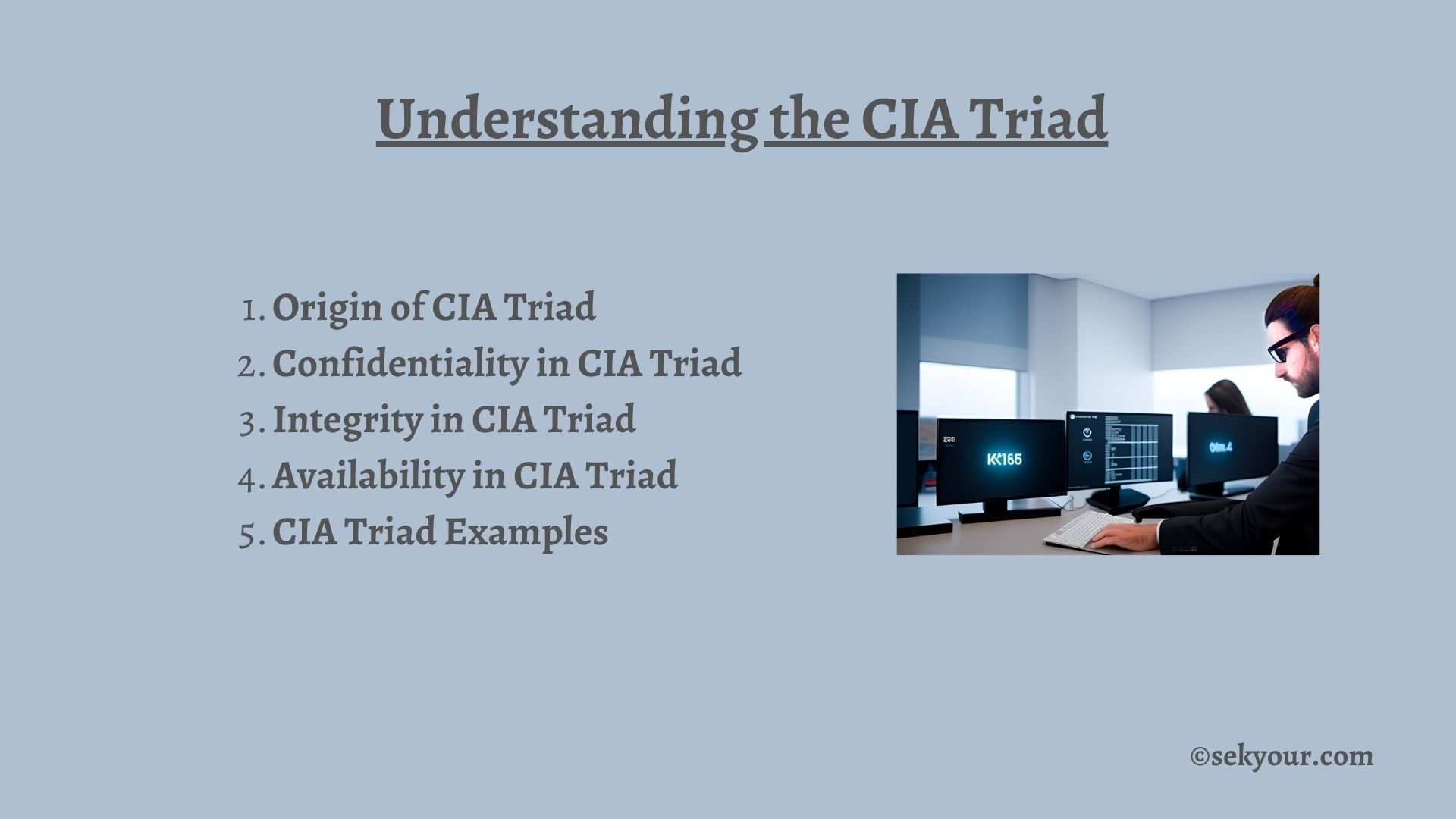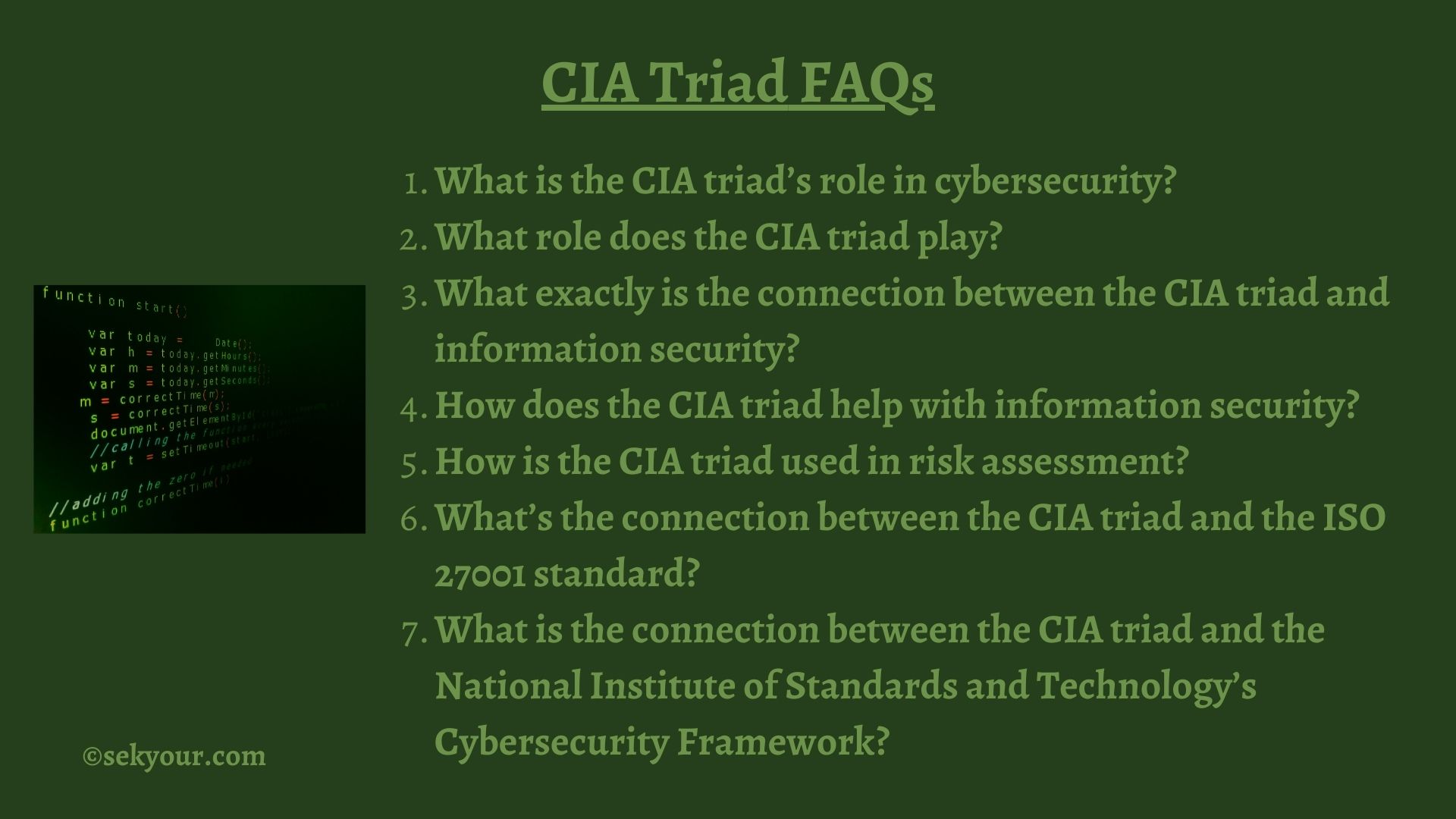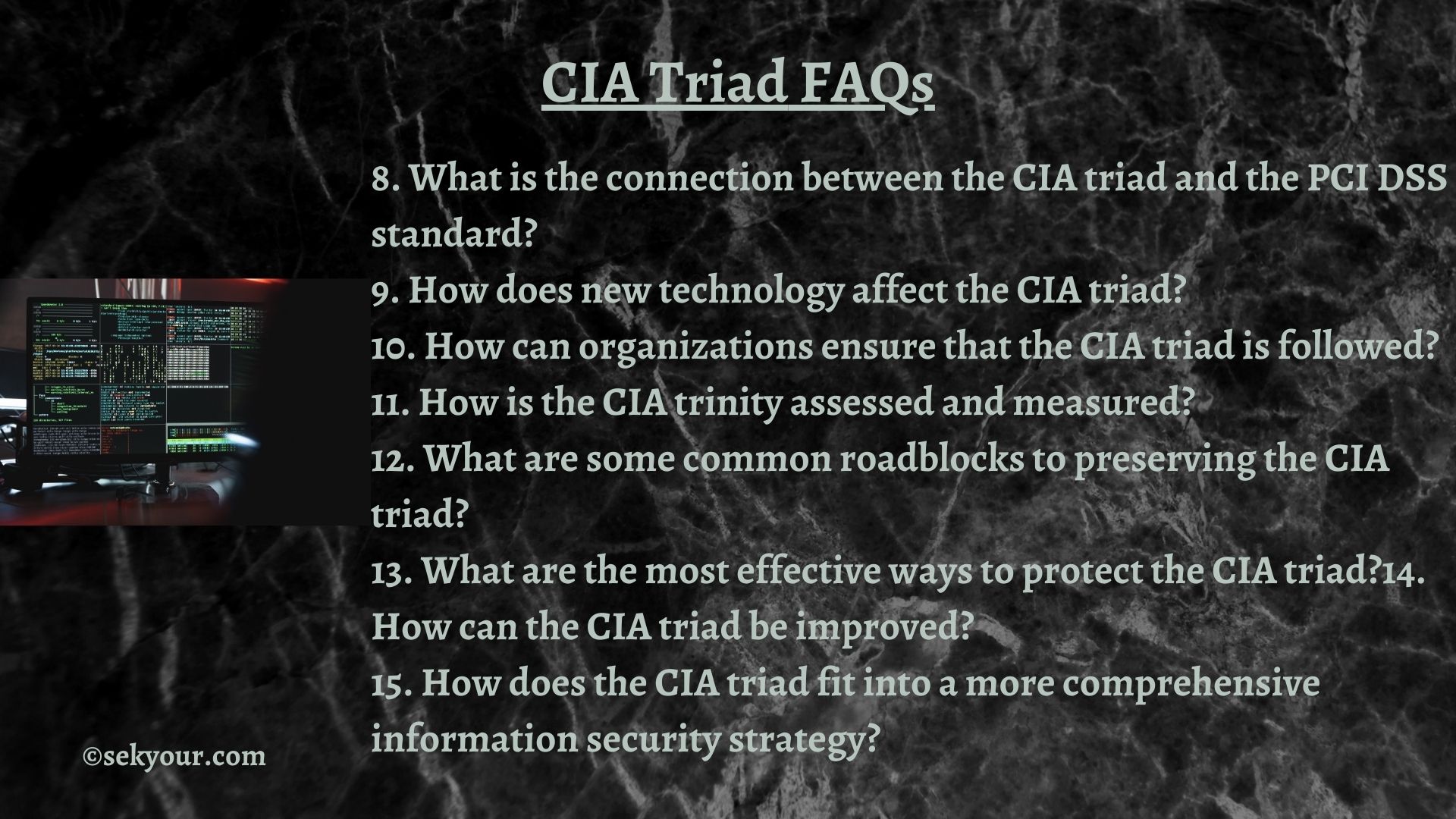Introduction
Protecting sensitive information from unauthorized disclosure or access is defined as confidentiality. Safeguarding sensitive data’s privacy is critical to prevent unauthorized individuals from accessing or using it.
Data precision and exhaustiveness are related to data integrity. Therefore, it is critical to maintaining data integrity to ensure it is trustworthy and reliable.
The ability of authorized users to obtain information when needed is referred to as availability. Therefore, it is critical to ensure that information systems are available to support company activities and meet user needs.
The CIA triad is essential in information security because it helps organizations protect sensitive data while maintaining the dependability and accessibility of information systems. As a result, firms can better defend themselves against cyber threats and ensure the continuous security of their plans by focusing on these three critical areas.

Origin of CIA Triad
Information security gave birth to the idea of the CIA triad, often referred to as the AIC triad or the Parkerian hexad. The paradigm was first presented in the 1980s by a man named Frederick B. Cohen, who discussed the significance of confidentiality, integrity, and availability in his book “Computer Security A Practitioner’s Approach.”
The CIA triad was popularized by Willis H. Ware, who discussed it in a study written and distributed by the RAND Corporation in 1993. According to Ware, the three components of the CIA triad are essential to information security and must be protected if information systems are to be kept secure.
Since its conception, the CIA triad has grown to be a well-known and significant paradigm in the world of information security. Organizations worldwide utilize it as a framework to comprehend and address the main security concerns they confront.
The model has also grown and changed over time to suit the shifting demands of the industry better. To better meet the needs of modern information systems, some have claimed, for instance, that the model should incorporate extra components, such as accountability and non-repudiation.
Confidentiality in CIA Triad
Confidentiality is safeguarding sensitive information from unauthorized access or exposure. It is a critical component of the CIA trifecta since it ensures that only authorized persons can access sensitive information.
Various methods are available to protect the secrecy of sensitive information, including Encryption transforming data into a coded format that only those with the correct decryption key can access. Encryption can be utilized to protect data privacy during storage and transmission.
Access controls guarantee that only authorized parties have access to sensitive information. Authentication of users, permissions, and access logs are examples of access controls.
Data masking is concealing or replacing sensitive data with fictitious data to make it more difficult for unauthorised users to obtain accurate data.
Classification of data requires labeling data according to its sensitivity and designing handling rules accordingly.
By applying these and other strategies, organizations can increase the confidentiality of sensitive information and reduce the risk of data breaches.
Integrity in CIA Triad
Integrity refers to a piece of data’s accuracy and comprehensiveness. It guarantees that data can be trusted and depended upon, making it a crucial part of the CIA trinity.
There are many methods for maintaining data integrity, including
Checksums: A checksum is a value generated from the contents of a file or communication to identify data changes. The checksum will change if the data is changed, informing the system that the data has been altered.
Hashing: The process of producing a fixed-size representation of a more significant piece of data is known as hashing. It is simple to identify data changes because the hash value changes whenever the original information is altered.
Digital Signature: A communication or document’s authenticity and integrity are verified using digital signatures, which are mathematical processes. It uses a private key to create a distinctive signature appended to the data and a public key to confirm the signature.
By using these and other methods, organizations can increase data integrity and lower the risk of data corruption.
Availability in CIA Triad
Availability refers to the capacity of authorized users to access information when necessary. It is a crucial element of the CIA trinity since it ensures that information systems can support the business and its users.
There are numerous ways to ensure the accessibility of information systems. Developing a strategy for recovering from a catastrophe, such as a natural disaster, power outage, or cyber assault, is known as disaster recovery planning. A disaster recovery plan should include methods for securing data, repairing systems, and quickly resuming operations.
Load balancing divides workloads across many servers or resources to optimize performance and availability. In addition, load balancing can prevent single points of failure and ensure that systems can manage heavy traffic or data volumes.
Redundancy refers to the utilization of numerous data copies or various systems such that, if one fails, the others can take over. Redundancy can increase system availability and reduce the likelihood of downtime.
Regular system monitoring and maintenance can help identify and resolve possible issues before they become problems. This includes checking for updates and patches, monitoring performance and consumption, and performing frequent backups.
By applying these and other strategies, organizations can increase the availability of their information systems and reduce the chance of downtime.
CIA Triad Examples
Confidentiality An organization may use encryption, access controls, and data masking to protect the confidentiality of sensitive data. An organization, for example, may use encryption to protect data in transit, access controls to limit access to sensitive data to authorized individuals, and masking to obscure sensitive data from unauthorized users.
To ensure data integrity, an organization may employ checksums, hashing, and digital signatures. Checksums, for example, can be used to detect changes in data, hashing can be used to create a unique representation of data that can be used to detect changes, and digital signatures can be used to verify the authenticity and integrity of data.
Availability, An organization may implement measures such as disaster recovery planning, load balancing, redundancy, and monitoring and maintenance to ensure the availability of information systems. For example, an organization may use disaster recovery planning to prepare for a disaster, load balancing to distribute workloads across multiple servers, redundancy to have multiple copies of data or various systems, and monitoring and maintenance to identify and address potential issues before they become problems.
These are just a few examples of how the CIA triad can be used. There are numerous other ways to improve the security of information systems by utilizing the concepts of confidentiality, integrity, and availability.
Conclusion
The CIA triad is critical in information security because it allows organizations to protect their sensitive data and systems' confidentiality, integrity, and availability. As a result, firms can better protect themselves against cyber threats and ensure the continuous security of their plans by focusing on these three critical areas.
To protect sensitive data and systems, businesses must incorporate the CIA triad concepts into their security policies. This could include implementing encryption and access controls to ensure confidentiality, checksums, and hashing to ensure data integrity, disaster recovery, and other measures to ensure availability.
If you want to learn more about the CIA trinity and how it can be implemented in your company, numerous internet resources can help you. You may also want advice and assistance from an information security specialist. Regardless of your level of expertise, staying current on information security best practices is critical to safeguard your systems and data.
CIA Triad FAQs

1. What is the CIA triad’s role in cybersecurity?
The CIA trinity is used in cybersecurity to protect sensitive information and systems from hacking, data breaches, and unauthorized access. It makes it easier to assess and manage information security risks and create policies and best practices for protecting the confidentiality, integrity, and availability of information and systems.
2. What role does the CIA triad play?
The CIA triad is intended to provide a framework for ensuring the security of sensitive data and systems. It helps businesses protect their information and systems' confidentiality, availability, and integrity, which is critical for the organization’s proper operation and safety.
3. What exactly is the connection between the CIA triad and information security?
The CIA triad is closely related to information security because it identifies the critical components that must be protected to secure sensitive data. It is used to assess and manage information security risks and develop strategies and best practices to protect information and systems from threats to confidentiality, integrity, and availability.
4. How does the CIA triad help with information security?
The CIA triad contributes to information security by ensuring that it is kept confidential, is not altered or destroyed without authorization, and is accessible to authorized users when needed.
5. How is the CIA triad used in risk assessment?
The CIA triad assists organizations in identifying and evaluating threats to the confidentiality, integrity, and availability of information and systems during risk assessment. It estimates the likelihood and severity of these hazards and develops strategies and controls to reduce or eliminate them.
6. What’s the connection between the CIA triad and the ISO 27001 standard?
The CIA triad is closely linked to ISO 27001, a global standard for information security management. A set of guidelines and requirements for establishing, implementing, maintaining, and constantly improving an information security management system (ISMS). The CIA trinity is an essential component of the ISMS because it provides a framework for protecting sensitive information and systems' confidentiality, integrity, and availability.
7. What is the connection between the CIA triad and the National Institute of Standards and Technology’s Cybersecurity Framework?
The CIA triad is also involved with the NIST Cybersecurity Framework (CSF), a set of standards and guidelines for dealing with cybersecurity threats. The CSF is intended to help businesses protect their data and systems' confidentiality, integrity, and availability. It is built around the CIA trinity.

8. What is the connection between the CIA triad and the PCI DSS standard?
The CIA triad is also linked to the PCI Data Security Standard (DSS), a set of guidelines for protecting cardholder data. Based on the CIA triad, the PCI Data Security Standard is intended to secure cardholder data by defining a set of controls and best practices.
9. How does new technology affect the CIA triad?
New technologies have an impact on the CIA triad in a variety of ways. New technology can introduce unknown risks and vulnerabilities and new ways to mitigate and manage these risks. Therefore, organizations must stay current with emerging technologies and their potential effects on the CIA triad to ensure the security of their information and systems.
10. How can organizations ensure that the CIA triad is followed?
Organizations can ensure compliance with the CIA trinity by developing and maintaining proper controls and practices for protecting the confidentiality, integrity, and availability of their information and systems. Adopting security policies and procedures, conducting risk assessments, implementing technical controls such as firewalls and encryption, and training personnel on best practices for information security are all possible.
11. How is the CIA trinity assessed and measured?
Typically, the CIA triad is evaluated and measured using risk assessments, which identify and analyze threats to information and system confidentiality, integrity, and availability. Risk assessments can be performed on an ongoing basis or in response to changes in an organization’s operations, technologies, or threat landscape.
12. What are some common roadblocks to preserving the CIA triad?
- Ensure that all employees understand and follow information security policies and procedures.
- Keeping a constant eye on the evolving threat landscape and new technologies
- ensuring that every system and device is configured correctly and secured
- Managing user access to information and the system
- Defending against external threats like hackers and malware.
13. What are the most effective ways to protect the CIA triad?
- Implementing and adhering to strict security procedures and policies
- Conducting risk assessments regularly and dealing with identified threats
- Using technological safeguards like firewalls and encryption
- Employee training in best practices for information security
- Patching and updating systems and software regularly
- Implementing access controls ensures that only authorized individuals have access to sensitive data and systems.
14. How can the CIA triad be improved?
Regularly evaluate and upgrade security policies and procedures, regularly conduct risk assessments, deploy new technologies and controls as needed, and educate staff on best information security practices.
15. How does the CIA triad fit into a more comprehensive information security strategy?
It provides a framework for ensuring the confidentiality, integrity, and availability of critical data and systems; the CIA triad is an essential component of a comprehensive information security strategy. It should be integrated into an organization’s holistic approach to information security and other controls and practices, such as incident response planning, access controls, and network security.